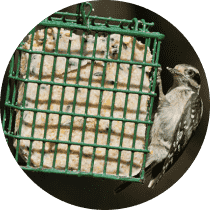White-headed Woodpecker
A species of Three-toed woodpeckers Scientific name : Leuconotopicus albolarvatus Genus : Three-toed woodpeckers
White-headed Woodpecker, A species of Three-toed woodpeckers
Botanical name: Leuconotopicus albolarvatus
Genus: Three-toed woodpeckers
Content
Description People often ask General Info
Description
The white-headed woodpecker (Leuconotopicus albolarvatus) is a non-migratory woodpecker that resides in pine forests of the mountains of western North America. It has a black body (approximately 20 cm (7.9 in) long) and white head. It has white primary feathers that form a crescent in flight. Males have a red spot at the back of the head. Some taxonomic authorities, including the American Ornithological Society, continue to place this species in the genus Picoides. The range of the white-headed woodpecker stretches in the mountains from British Columbia through southern California. They form nests in dead trees or snags and reproduce once per year. Most of the range is occupied by the nominate subspecies. In the southern part of the range, L. a. gravirostris, which has a longer bill - especially in males - and tail, is only found on mountaintops of the San Gabriel Mountains to San Diego County. Birds on Mount Pinos are somewhat intermediate. mtDNA cytochrome b and ATP synthase subunit 6 sequence data confirms this arrangement and also suggests that the Mount Pinos birds are closer to L. a. gravirostris (Alexander & Burns, 2006). Apparently, the larger bill of the southern subspecies is an adaptation for being better able to feed on the large, spiny cones of Coulter pines (Pinus coulteri). 
Size
24 cm
Colors
Black
Red
White
Life Expectancy
10-15 years
Nest Placement
Cavity
Feeding Habits
White-headed Woodpecker primarily feed on pine seeds from ponderosa, sugar, Coulter, and Jeffrey pines, rarely knobcone pine or white fir. They pry or hammer cones, often transporting seeds to favorite spots to eat. Additionally, white-headed Woodpecker forage for insects like ants, termites, and beetles, probing bark and pine needles. They also create sapwells for pine sap. Males may forage differently than females, varying in height and activity. Occasionally, white-headed Woodpecker glean seeds or insects from lower vegetation and visit suet feeders.
Habitat
White-headed Woodpecker primarily inhabit mountainous pine forests in the western regions of North America, preferring elevations where old-growth ponderosa and sugar pines thrive in a partly open canopy environment. They are adapted to forested landscapes with sparse understories and significant presence of dead trees for nesting, particularly those areas rich in pine seed production or affected by recent fires. Their habitat also includes a mix of conifers and hardwoods like firs, cedars, Douglas-firs, and various oaks, but they generally avoid forests dominated by tree species with small pine cones.
Nest Behavior
Both male and female white-headed Woodpecker collaboratively excavate the nest cavity. They engage in nest building and egg-laying primarily in the spring. After egg deposition, both parents participate in incubation and later in feeding and nurturing the young.
Nest Characteristics
White-headed Woodpecker typically nests in dead conifers or dead portions of living conifers, occasionally in deciduous trees. The nest, excavated by both sexes, averages 5.1 inches wide and 8.3 inches deep with a 1.8-inch entrance hole, situated around 8 feet off the ground.
Dite type
Insectivorous
People often ask
General Info
Feeding Habits
Bird food type
Bird Feeder Type

Suet Cage
Behavior
White-headed Woodpecker exhibit monogamous tendencies and may pair for life, often remaining together throughout the year. In spring, they engage in drumming to establish nesting territories and utilize both visual and auditory signals to maintain pair bonds and repel intruders. Their courtship includes crest raising, head swinging, and an unusual 'moth' flight display. Aggressive encounters are rare, with confrontations typically involving silent, intimidating posturing. Both sexes play equal roles in incubation and nurturing of their offspring. By autumn, fledglings gain independence from parental care.
Scientific Classification
Phylum
Chordates Class
Birds Family
Woodpeckers Genus
Three-toed woodpeckers Species
White-headed Woodpecker 